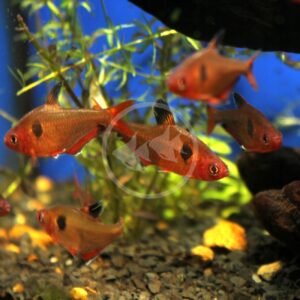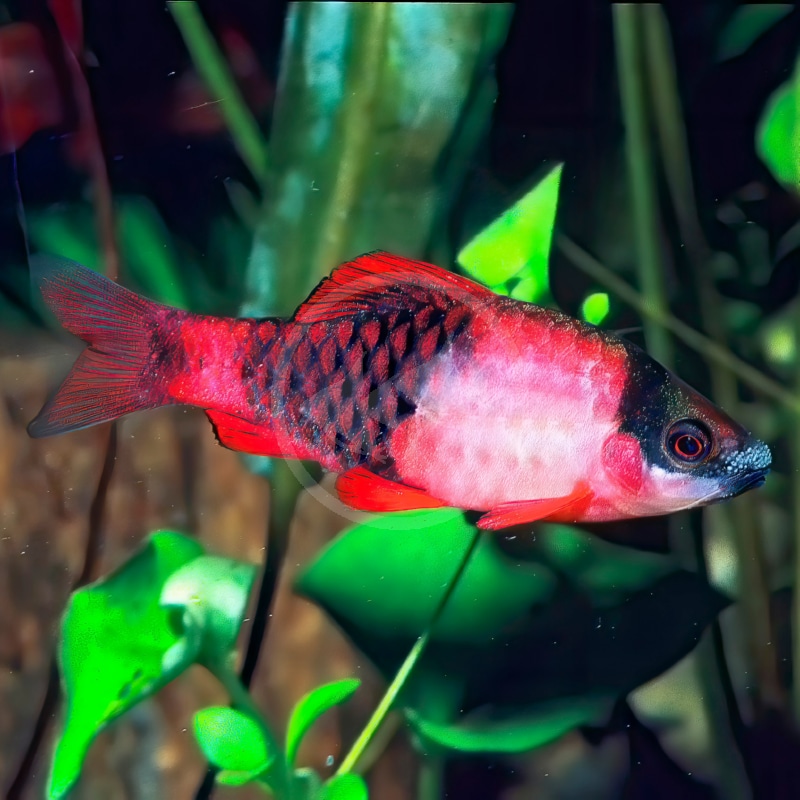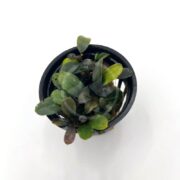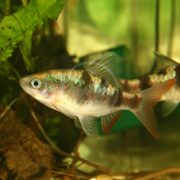BARB – MELON / PANDA
Haludaria fasciata
$6.99 – $12.99Price range: $6.99 through $12.99
The Panda Barb, sometimes referred to as the Melon Barb, has a wide and patchy distribution throughout India. Because of this distribution, there is considerable variation in color and patterning of Panda barbs. For example, some populations have an orange-red color, while others appear more red-purple. Additionally, the number of stripes on Panda barbs vary to these isolated populations. Many of the Panda barbs available within the aquarium trade are commercially produced however, though this variation can still be found within aquaculture or if wild specimens are intermixed. Panda barbs typically exhibit sexual dimorphism – males possess more striking coloration than females, and females will also appear more round in shape. Juvenile or young Panda barb males can also look like females. Despite “barb” in their name, Panda barbs are somewhat peaceful compared to the boisterous barb species we think of (e.g., Puntius tetrazona [Tiger Barb, Green Tiger Barb], P. padamya [Odessa Barb]). Sometimes nippy behavior can be exhibited from Panda barbs when they are kept in too small of an aquarium and in too few of numbers. Panda barbs make for an excellent addition into the well researched community aquarium. A natural schooling fish, Panda barbs require at least 8 to 10 individuals. More than one male can be kept in a school, but they may occasionally flare up at one another to gain the attention of females. Having females in the group will also encourage males to display their best coloration. An adult Panda barb can reach a size of approximately 2.5″. Panda barbs are one of the few cyprinids that will graze on nuisance algae.
Care Level: Easy
Temperament: Semi-Aggressive
Live Plant Safe: Yes
General Description: The Panda Barb, sometimes referred to as the Melon Barb, has a wide and patchy distribution throughout India. Because of this distribution, there is considerable variation in color and patterning of Panda barbs. For example, some populations have an orange-red color, while others appear more red-purple. Additionally, the number of stripes on Panda barbs vary to these isolated populations. Many of the Panda barbs available within the aquarium trade are commerically produced however, though this variation can still be found within aquaculture or if wild specimens are intermixed. Panda barbs typically exhibit sexual dimorphism – males possess more striking coloration than females, and females will also appear more round in shape. Juvenile or young Panda barb males can also look like females. Despite “barb” in their name, Panda barbs are somewhat peaceful compared to the boisterous barb species we think of (e.g., Puntius tetrazona [Tiger Barb, Green Tiger Barb], P. padamya [Odessa Barb]). Sometimes nippy behavior can be exhibited from Panda barbs when they are kept in too small of an aquarium and in too few of numbers. Panda barbs make for an excellent addition into the well researched community aquarium. A natural schooling fish, Panda barbs require at least 8 to 10 individuals. More than one male can be kept in a school, but they may occasionally flare up at one another to gain the attention of females. Having females in the group will also encourage males to display their best coloration. An adult Panda barb can reach a size of approximately 2.5″. Panda barbs are one of the few cyprinids that will graze on nuisance algae.
Diet Requirements: In the wild Panda barbs are omnivores. A diet made up of various high quality vegetable based and protein based flake foods, sinking micro pellet foods and bug bites are ideal, in addition to offering frozen foods such as bloodworms, brine shrimp and daphnia. Some emphasis should be put on offering ample plant or algal based foods for this species. Variety is the spice of life in order to maintain color, immune function and longevity of your fish.
Care Requirements: A minimum 30 to 55 gallon aquarium is ideal for a group of Panda barbs. While Panda barbs are relatively hardy, this species would prefer to be put into a biologically mature aquarium. The aquarium does not need to be aquascaped with anything in particular to keep a school of Panda barbs happy, but a darker-neutral sandy substrate, driftwood and other natural-looking arrangements will bring out the beauty of this barb. This barb can appear washed out in sparsely decorated set ups. Panda barbs have been observed to show exceptional coloration in dense live planted aquariums. In the proper environment, Panda barbs can be relatively peaceful compared to Tiger Barbs in which they are usually lumped with in terms of temperament. However, we do not recommend mixing this barb with fish that are timid, slow-moving, or that have decorative fins. In nature, Panda barbs are found in mixed schools with Arulius (Puntius arulius) and Filament (Dawkinsia filamentosa) barbs. Recommended water conditions, 72-78° F, KH 5-12, pH 6.0-7.5.
Purchase Size: Medium: 1-1/4” to 1-1/2”
Note: Your item may not look identical to the image provided due to variation within species. Purchase sizes are approximate.
Dry goods orders are shipped via US Postal Service or UPS to the address provided at checkout based on the selection made in your website shopping cart. Product is carefully packed to help prevent any damage during shipping. Once processed you will receive a shipment notification via email with tracking number, and delivery notification. Please allow 48 hours for processing after your order is placed.
Perishable items (i.e. live plants, refrigerated/frozen foods) are shipped via US Postal Service 2-3 day to the address provided at checkout for a $25.00 flat rate charge. Items are packed with secure packing material and heat, cold, or Cryo packs as needed to maintain safe temperatures during transit. If one or more perishable items are in the shopping cart at checkout the $25.00 perishable shipping charge will automatically appear and need to be selected. Once processed you will receive a shipment notification via email with tracking number. Please allow 48 hours for processing after your order is placed.
Livestock (i.e. fish, invertebrates, coral) are shipped via UPS Overnight to the address provided at checkout for a $55.00 flat rate charge. Livestock is packed in insulated styrofoam boxes with secure packing material and heat, cold, or Cryo packs as needed to maintain safe temperatures during transit. If one or more livestock items are in the shopping cart at checkout the $55.00 livestock shipping charge will automatically appear and need to be selected. Livestock is shipped Monday through Wednesday ONLY (no weekend delivery is available) weather permitting, and we reserve the right to delay shipping until conditions are appropriate for safe arrival. Once your order is placed we will contact you to arrange the best shipping date based on these criteria. Someone must be available to receive the livestock order on the first delivery attempt. Once processed you will receive a shipment notification via email with tracking number. Please allow 48 hours for processing after your order is placed.
For mixed dry goods/perishable & livestock orders items will be shipped via their corresponding shipping methods outlined above. Dry goods will be shipped via US Postal Service or UPS based on your selection and checkout, while livestock will ship via UPS Overnight for a $55.00 flat rate charge. You will receive separate notifications and tracking numbers for the dry goods and livestock. Please note due to different carriers and shipping methods dry goods and livestock may arrive on different days.
Related products
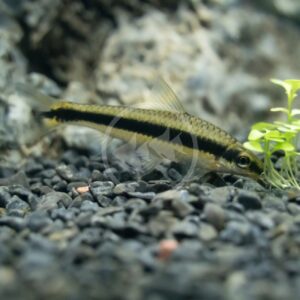
ALGAE EATER – SIAMESE / SAE
Crossocheilus oblongus
$7.99 – $24.99Price range: $7.99 through $24.99

PLECOSTOMUS – BRISTLENOSE ALBINO / GOLD
Ancistrus sp.
$5.99 – $59.99Price range: $5.99 through $59.99
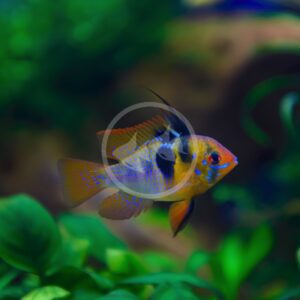
CICHLID – RAM GERMAN BLUE
Mikrogeophagus ramirezi
$12.99 – $24.99Price range: $12.99 through $24.99

GOURAMI – DWARF POWDER BLUE
Trichogaster lalius
$11.99 – $16.99Price range: $11.99 through $16.99

CICHLID – RAM GERMAN GOLD
Mikrogeophagus ramirezi
$5.99 – $26.99Price range: $5.99 through $26.99

ANGELFISH – FW GOLD
Pterophyllum scalare
$9.99 – $19.99Price range: $9.99 through $19.99

ANGELFISH – FW PLATINUM
Pterophyllum scalare
$6.99 – $29.99Price range: $6.99 through $29.99
